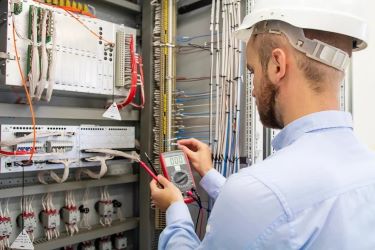
Electricians install, maintain, and repair electrical power, and lighting systems. Installing electrical systems in newly constructed buildings is easier than maintaining existing buildings, because electrical wiring is more accessible during construction. Electricians read blueprints, which include technical diagrams of electrical systems that show the location of circuits, outlets, and other equipment.
While troubleshooting, electricians also may use ammeters, voltmeters, thermal scanners, and cable testers to find problems and ensure that components are working. Although a few accidents are potentially fatal, common injuries include electrical shocks, falls, burns, and other minor injuries.
Some electrical contractors have their own training programs, which include both classroom and on-the-job training. The Home Builders Institute offers a preapprenticeship certificate training (PACT) program for eight construction trades, including electricians. After completing an apprenticeship program, electricians are considered to be journey workers and may perform duties on their own, subject to local and state licensing requirements.
Most electricians learn their trade in a four to five-year apprenticeship program. For each year of the program, apprentices typically receive 2,000 hours of paid on-the-job training as well as some classroom instruction. In the classroom, apprentices learn electrical theory, blueprint reading, mathematics, electrical code requirements, and safety and first-aid practices. Several groups, including unions and contractor associations, sponsor apprenticeship programs.
States require electricians to pass a test and be licensed. Requirements vary by state. For more information, contact your local or state electrical licensing board. Requirements can be found on the National Electrical Contractors Association's website. The tests have questions related to the National Electrical Code and state and local electrical codes. Further, electricians may be required to take continuing education courses in order to maintain their licenses.
Electrician Certification is foundational for anyone aspiring to work in the electrical industry. It typically involves completing an apprenticeship program, which combines on-the-job training with classroom instruction. Apprentices learn about electrical theory, wiring techniques, safety practices, and local building codes. Once the apprenticeship is completed, candidates must pass an exam administered by a certifying body, such as a state licensing board or a professional organization like the National Electrical Contractors Association (NECA) or the Independent Electrical Contractors (IEC).
| Certification Level | Skills Required |
| Apprentice Electrician |
|
| Journeyman Electrician |
|
| Master Electrician |
|
Electrical work comes with inherent risks, including electrical shock, fire hazards, and arc flashes. Training typically covers topics such as identifying electrical hazards, using personal protective equipment (PPE) correctly, implementing lockout/tagout procedures, and understanding relevant safety regulations such as the National Electrical Code (NEC) or Occupational Safety and Health Administration (OSHA) standards.
Electrical Installation Certificate (EIC) is crucial for electricians who install wiring, circuits, and electrical systems in residential, commercial, or industrial settings. Upon completing an installation project, electricians issue an Electrical Installation Certificate to confirm that the work complies with all applicable regulations and standards. Inspectors may require this certificate before approving a new installation or before connecting it to the power supply.
Running wire to the electrical boxes, wire nut placement, applying wires to switch screws, tighten ground first, screw switch to electrical box.
Build your base knowledge including how to measure both alternating current and direct current voltage with a multimeter.
The electrical blueprint drawings consist of symbols for electrical outlets, fixtures, switches, lighting, fans, and appliances.
Everyday tools as an commercial electrical contractor. Each tool explained.
Ask yourself if you can see yourself as a professional electrician, having daily contact with the public. In today's competitive environment, you are well-advised to attend an electrician training program, as well as perform an apprenticeship. While classes and internships will prepare you well, certain innate qualities that you bring to bear will help you succeed.
Attending college offers benefits beyond academic learning. Students are exposed to diverse perspectives that challenge their thinking. This fosters problem-solving and communication. College is also about social skills. Whether through student organizations or sports teams, students develop leadership skills and build lasting friendships.
This website is not affiliated with any educational institution, and all trademarks are the exclusive property of the respective owners. All copyrighted works on this website are offered for educational purposes only, governed by the four-factor rule, section 107 of the Copyright Act. CampusInspector.com is the work of a group of students in Bangkok, using data from the US Department of Education, Postsecondary Education Data System (IPEDS). If any information is incorrect, please contact us with updates.